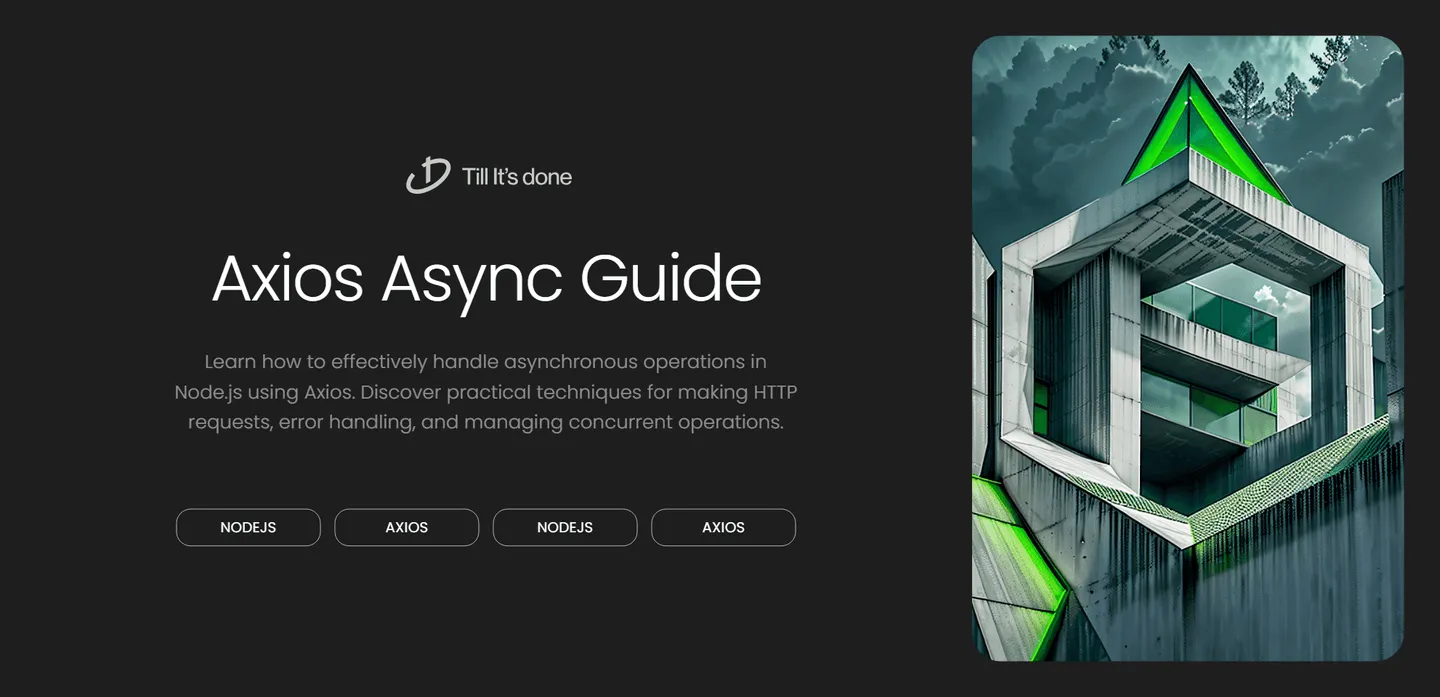- Services
- Case Studies
- Technologies
- NextJs development
- Flutter development
- NodeJs development
- ReactJs development
- About
- Contact
- Tools
- Blogs
- FAQ
Master Async Operations with Axios in Node.js
Discover practical techniques for making HTTP requests, error handling, and managing concurrent operations.

Handling Asynchronous Operations with Axios in Node.js

In today’s fast-paced web development landscape, handling HTTP requests efficiently is crucial. As a Node.js developer, I’ve found Axios to be an invaluable tool for managing asynchronous operations. Let’s dive into how we can master asynchronous requests using Axios in Node.js applications.
Understanding Axios Basics
When I first started working with Axios, I was amazed by its elegant promise-based structure. At its core, Axios simplifies HTTP requests while providing powerful features out of the box. Here’s how we can make basic GET and POST requests:
const axios = require('axios');
// Making a GET requestasync function fetchUserData() { try { const response = await axios.get('https://api.example.com/users'); return response.data; } catch (error) { console.error('Error fetching users:', error.message); }}
Advanced Error Handling
One thing I’ve learned through experience is that robust error handling can make or break your application. Axios provides multiple ways to handle errors gracefully:
const makeApiRequest = async () => { try { const response = await axios.post('https://api.example.com/data', { name: 'John', age: 30 }); console.log('Success:', response.data); } catch (error) { if (error.response) { // Server responded with an error status console.error('Server Error:', error.response.status); } else if (error.request) { // Request was made but no response received console.error('Network Error'); } else { // Something else went wrong console.error('Error:', error.message); } }};Concurrent Requests with Promise.all
Sometimes we need to handle multiple requests simultaneously. Axios works beautifully with Promise.all, allowing us to execute parallel requests efficiently:

async function fetchMultipleEndpoints() { try { const endpoints = [ 'https://api.example.com/users', 'https://api.example.com/posts', 'https://api.example.com/comments' ];
const requests = endpoints.map(endpoint => axios.get(endpoint)); const responses = await Promise.all(requests);
return responses.map(response => response.data); } catch (error) { console.error('One or more requests failed:', error); }}Interceptors and Global Configuration
Working with Axios becomes even more powerful when you utilize interceptors and global configurations. These features have saved me countless hours of repetitive coding:
// Global configurationaxios.defaults.baseURL = 'https://api.example.com';axios.defaults.timeout = 5000;
// Request interceptoraxios.interceptors.request.use(config => { config.headers['Authorization'] = `Bearer ${getToken()}`; return config;}, error => { return Promise.reject(error);});
// Response interceptoraxios.interceptors.response.use(response => { return response;}, error => { if (error.response.status === 401) { // Handle unauthorized access refreshToken(); } return Promise.reject(error);});Remember, when working with asynchronous operations, it’s crucial to maintain a balance between performance and code readability. Axios helps achieve both, making it an excellent choice for modern Node.js applications.

 สร้างเว็บไซต์ 1 เว็บ ต้องใช้งบเท่าไหร่? เจาะลึกทุกองค์ประกอบ website development cost อยากสร้างเว็บไซต์แต่ไม่มั่นใจในเรื่องของงบประมาณ อ่านสรุปเจาะลึกตั้งแต่ดีไซน์, ฟังก์ชัน และการดูแล พร้อมตัวอย่างงบจริงจาก Till it’s done ที่แผนชัด งบไม่บานปลายแน่นอน
สร้างเว็บไซต์ 1 เว็บ ต้องใช้งบเท่าไหร่? เจาะลึกทุกองค์ประกอบ website development cost อยากสร้างเว็บไซต์แต่ไม่มั่นใจในเรื่องของงบประมาณ อ่านสรุปเจาะลึกตั้งแต่ดีไซน์, ฟังก์ชัน และการดูแล พร้อมตัวอย่างงบจริงจาก Till it’s done ที่แผนชัด งบไม่บานปลายแน่นอน  Next.js สอน 14 ขั้นตอนเบื้องต้น: สร้างโปรเจกต์แรกใน 30 นาที เริ่มต้นกับ Next.js ใน 14 ขั้นตอนเพียงแค่ 30 นาที พร้อม SSR/SSG และ API Routes ด้วยตัวอย่างโค้ดง่าย ๆ อ่านต่อเพื่อสร้างโปรเจ็กต์แรกได้ทันทีที่นี่
Next.js สอน 14 ขั้นตอนเบื้องต้น: สร้างโปรเจกต์แรกใน 30 นาที เริ่มต้นกับ Next.js ใน 14 ขั้นตอนเพียงแค่ 30 นาที พร้อม SSR/SSG และ API Routes ด้วยตัวอย่างโค้ดง่าย ๆ อ่านต่อเพื่อสร้างโปรเจ็กต์แรกได้ทันทีที่นี่  วิธีสมัคร Apple Developer Account เพื่อนำแอปขึ้น App Store ทีละขั้นตอน อยากปล่อยแอปบน App Store ระดับโลก มาอ่านคู่มือสมัคร Apple Developer Account พร้อมเคล็ดลับ TestFlight และวิธีอัปโหลดที่ง่ายในบทความเดียวนี้ได้เลย
วิธีสมัคร Apple Developer Account เพื่อนำแอปขึ้น App Store ทีละขั้นตอน อยากปล่อยแอปบน App Store ระดับโลก มาอ่านคู่มือสมัคร Apple Developer Account พร้อมเคล็ดลับ TestFlight และวิธีอัปโหลดที่ง่ายในบทความเดียวนี้ได้เลย  TypeScript Interface คืออะไร? อธิบายพร้อมวิธีใช้และข้อแตกต่างจาก Type เรียนรู้วิธีใช้ TypeScript Interface เพื่อสร้างโครงสร้างข้อมูลที่ปลอดภัยและเข้าใจง่าย พร้อมเปรียบเทียบข้อดีข้อแตกต่างกับ Type ที่คุณต้องรู้ ถูกรวมเอาไว้ในบทความนี้แล้ว
TypeScript Interface คืออะไร? อธิบายพร้อมวิธีใช้และข้อแตกต่างจาก Type เรียนรู้วิธีใช้ TypeScript Interface เพื่อสร้างโครงสร้างข้อมูลที่ปลอดภัยและเข้าใจง่าย พร้อมเปรียบเทียบข้อดีข้อแตกต่างกับ Type ที่คุณต้องรู้ ถูกรวมเอาไว้ในบทความนี้แล้ว  Material-UI (MUI) คืออะไร อยากสร้าง UI สวยงามและเป็นมืออาชีพในเวลาอันรวดเร็วใช่ไหม มาทำความรู้จักกับ Material-UI (MUI) ที่ช่วยให้คุณพัฒนาแอปพลิเคชันบน React ได้ง่ายและดูดีในทุกอุปกรณ์
Material-UI (MUI) คืออะไร อยากสร้าง UI สวยงามและเป็นมืออาชีพในเวลาอันรวดเร็วใช่ไหม มาทำความรู้จักกับ Material-UI (MUI) ที่ช่วยให้คุณพัฒนาแอปพลิเคชันบน React ได้ง่ายและดูดีในทุกอุปกรณ์  เปรียบเทียบ 3 วิธีติดตั้ง install node js บน Ubuntu: NVM vs NodeSource vs Official Repo แบบไหนดีที่สุด? เรียนรู้วิธีติดตั้ง Node.js บน Ubuntu ด้วย NVM, NodeSource หรือ Official Repo เลือกวิธีที่เหมาะกับความต้องการของคุณ พร้อมเปรียบเทียบ เพื่อการพัฒนาที่มีประสิทธิภาพ!
เปรียบเทียบ 3 วิธีติดตั้ง install node js บน Ubuntu: NVM vs NodeSource vs Official Repo แบบไหนดีที่สุด? เรียนรู้วิธีติดตั้ง Node.js บน Ubuntu ด้วย NVM, NodeSource หรือ Official Repo เลือกวิธีที่เหมาะกับความต้องการของคุณ พร้อมเปรียบเทียบ เพื่อการพัฒนาที่มีประสิทธิภาพ! Talk with CEO
We'll be right here with you every step of the way.
We'll be here, prepared to commence this promising collaboration.
Whether you're curious about features, warranties, or shopping policies, we provide comprehensive answers to assist you.


